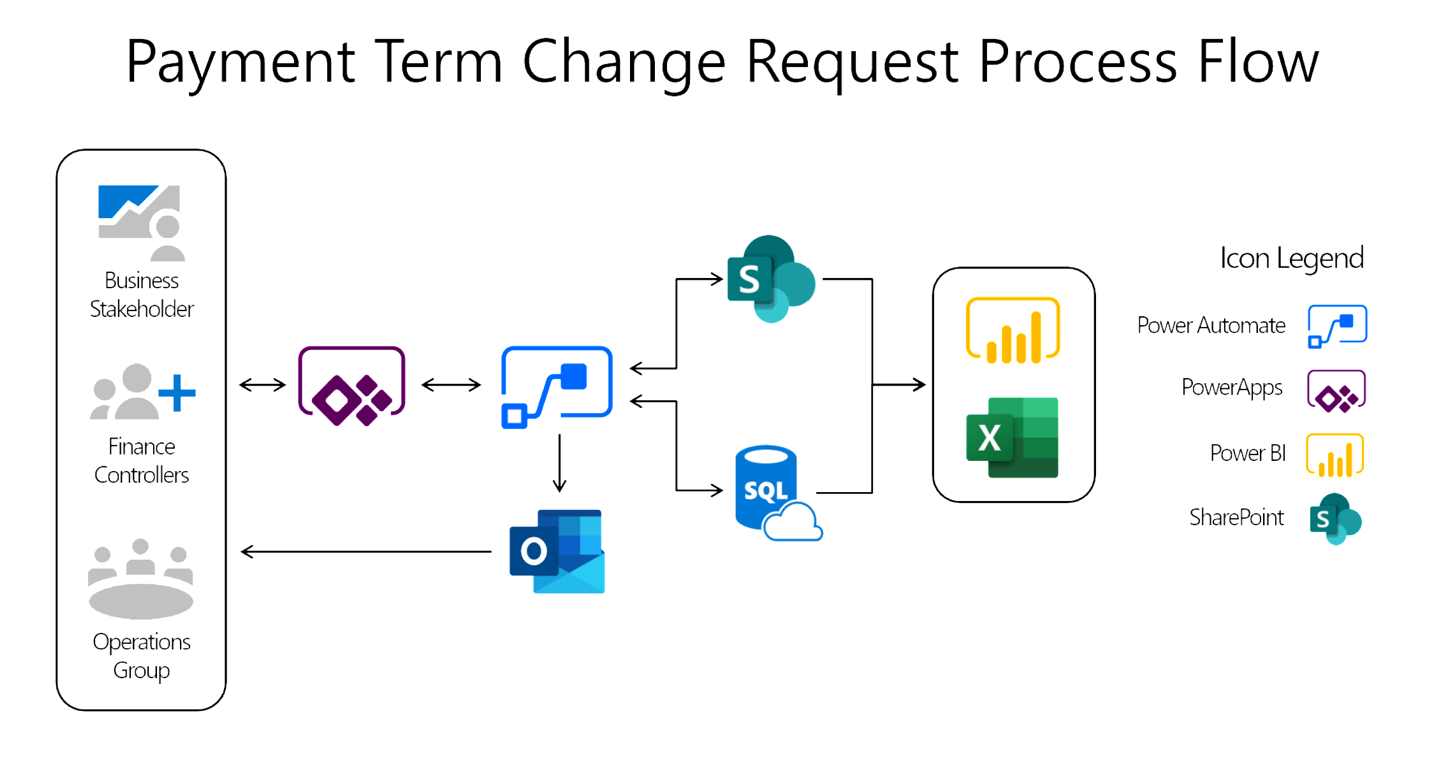This content has been archived, and while it was correct at time of publication, it may no longer be accurate or reflect the current situation at Microsoft.
 Sometimes it’s best to take matters into your own hands.
Sometimes it’s best to take matters into your own hands.
Tanner Busby, Binu Surendranath, Russell Maw, and Korry Kelley aren’t developers. But that didn’t stop them from building a smart platform to automate a process that was stuck in the ’90s.
In 2019, Surendranath and Busby were part of Microsoft’s global Accounts Payable team, while Maw and Kelley worked in Procurement. They were all familiar with how Microsoft handles requests to change supplier payment terms.
Historically, when a finance professional needed to automate a process, they enlisted Microsoft Digital to build it for them. But thanks to Microsoft Power Automate, they can now build solutions themselves.
That keeps projects off Microsoft Digital’s plate and makes for quicker turnarounds. “Like a lot of IT departments, Microsoft Digital’s services are in high demand,” says Busby, who is the service deliveries lead for the Americas.
[Learn how Microsoft used Microsoft Azure to transform its cash flow business. Read about how Microsoft uses AI and chatbots to simplify finance tools at Microsoft. Check out how Microsoft created efficiencies in finance with Microsoft Dynamics 365 and machine learning.]
Digitizing a manual process with Microsoft Power Automate
The team built the platform to solve a common problem: a deeply entrenched, heavily manual process was clogging up the gears.
Each Microsoft supplier and partner enters into an agreement with Microsoft that stipulates, among other things, when payment is to be made to the supplier for goods received or services rendered. Sometimes, the supplier or partner requests that the payment be made in a way that deviates from the agreement.
“Those requests are common, and they don’t just come from suppliers,” says Maw, director of procurement services. “They might come from a Microsoft business group, procurement, or leadership.”
Almost all of the requests came in by email.
“Most of those requests went through my team,” Maw says. “We would compare it to the original agreement and determine whether or not to approve the request.”
There was also no centralized approval authority.
“Anyone in the company could send a request to any Accounts Payable (AP) support alias globally,” Busby says. “AP would manage the ticket—again manually—and analyze it. They’d send an email to Russell’s team. Then his team would analyze it and make a decision, and send an email back to AP, who would pick it up and proceed. It was all terribly manual.”
As complicated manual processes tend to do, things got messy.
“There were no criteria as to what to put in that email to request a payment term change,” Busby says. “From that point, it was back-and-forth emails trying to get the right data, the purchase order number, and many, many other criteria.”
The requests added up. “I would get 40 to 50 of these requests a week, sometimes 25 a day,” Maw says.
The result was a drain on productivity, lack of visibility into the process, and discounts that weren’t frequently applied. Automation was the obvious solution.
Collecting data to iterate quickly
Surendranath, a group global process owner at Microsoft, built the first version with Busby’s input in just five weeks. The initial release included minimal functionality.
“We were just scratching the surface with the first version,” Surendranath says. “We wanted it out in the world so we could collect feedback and iterate from there.”
He soon looped in Maw to create a standardized version of the process.
“It wasn’t just a matter of taking a manual process and then automating,” Maw says. “We had to build the process. Then we built an app around that process.”
The proof of concept went live in July 2019. By December, the team had their first full quarter of data to analyze.
“We got a sense of the volume, where the requests originated from, which business group, that sort of thing,” Surendranath says.
They also collected feedback from other requestors, their peers at Microsoft, and leadership. In many cases, the rapid iteration enabled by Microsoft Power Automate allowed the team to adapt the platform based on feedback and suggestions in near-real time.
“There were many instances where users gave us suggestions or enhancements and the team finished the implementation of those suggestions before the meeting was over,” Surendranath says.
Korry Kelley, a senior data scientist, was brought in to flesh the platform out.
“Korry did a lot of the initial creation,” Surendranath says. “He brought some best practices over from his experience with the Microsoft product team and drove our scalability efforts.”
To save time, Kelley reused some components from previous projects like the layout, skin, and data source.
“V1 was basically just an input form,” Kelley says. “We were collecting data. There was no extensive reporting, it just gave us an indication of volume.”
In December 2019, the team got to work on V2, which was released on February 1, 2020. With plenty of data and user feedback to draw from, the platform began to look like an enterprise-ready product.
“V2 was a one-stop shop, a single window for submission, approval, tracking and configuration,” Kelley says. “We also built out the operational management functionality and added triggered notification emails to stakeholders. We gave process admins the ability to add and remove finance controller approvers, and for approvers to delegate that responsibility when needed. It was a groundbreaking user experience in a line-of-business offering. You don’t generally see that kind of experience without going to IT and having them build something from scratch.”

In the new platform, a business stakeholder kicks off the process by submitting a new request for a payment term change in the app. Based on the decision engine and business rules configuration, this request gets routed automatically to the corresponding finance controller, who’s notified by email and in the app. The finance controller reviews the request, asking for any additional details that they may need through the app. When the request is approved, Finance Operations executes the approved changes.
Microsoft Power Automate executes the entire workflow, reading and writing the supplier data to the Azure SQL backend and transactional data to Microsoft SharePoint, and sending emails to any relevant parties that need to take action. Stakeholders can view a snapshot of queued requests in a Microsoft Power BI dashboard and download that data to Microsoft Excel.
Collecting data to solve problems
Because Maw was so close to the process, he saw the potential to solve problems through the trove of data the platform was collecting.
“Let’s say that 80 percent of all requests get approved,” Maw says. “We wanted to find out why that’s the case. Tracking certain info allows us to update other aspects of our systems at the purchase order creation level, or even at the policy level.”
That data could then inform future optimizations.
“We could make tweaks that would lower the number of requests made in the first place to 500 a month,” Maw says. “Then data from that version of the platform might give us what we need to get down to 300 or 200 a month. The idea is we just keep making the process better until the problem goes away.”
The impact of automation
The platform is already processing around 600 transactions per month globally, resulting in about 5,000 hours’ worth of efficiency gains.
Those gains come from a 30 percent reduction in the number of tickets and reduced errors stemming from automatic form validations. Automated routing also contributes by ensuring that only those who need to take action are looped in.
Then there’s the elimination of all those emails and the occasional Microsoft Teams call to nail down minor details.
In addition, service-level agreements (SLAs) now take about three days to turn around, when previously they took twice that.
“We saved days on SLAs,” Busby says. “Literally.”
Surendranath echoed this statement.
“It’s improving productivity across the board,” Surendranath says, “including internal users, the Business Process Outsourcing team, and external suppliers.”
And because the entire process is now automated and centralized, nothing falls through the cracks, ensuring 100 percent compliance and leaving a comprehensive audit trail.
In the near-term, the team plans to expand the scope of the platform to encompass a wider range of policies, and to modularize some of the components for reuse.
But the real future of the platform lies in the actionable insights that are already being extracted from the data it collects.
“We’re close to 80 percent adherence to standard requirements already,” Maw says, “and of the remaining 20 percent, we know why 15 percent is non-standard, which is huge. That really narrows our focus on the remaining 5 percent.”
The team learned the ins and outs of Microsoft Power Automate by watching tutorial videos on the Microsoft Power Automate YouTube channel. The DIY nature of the project was quite satisfying, Kelley says. “Think about it. We built a full-featured enterprise app, complete with automation and reporting, without any heavy coding.”
It was also kind of fun, Busby explains.
“We would brainstorm, and Korry and Binu would mock things up in a day or two, then come back and show us what the idea looked like,” Busby says. “We saw our ideas come to life in a matter of days rather than weeks, and we could iterate from there. It was awesome.”







